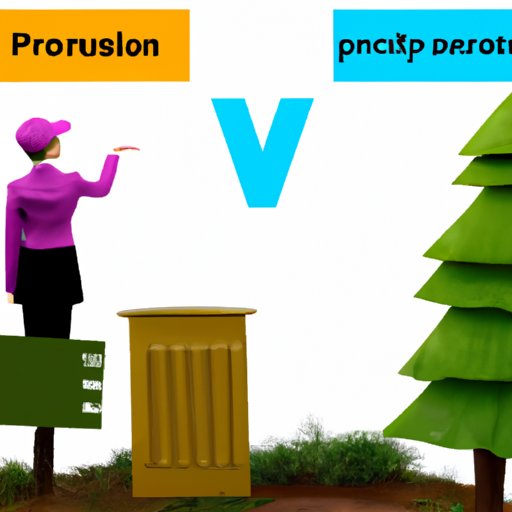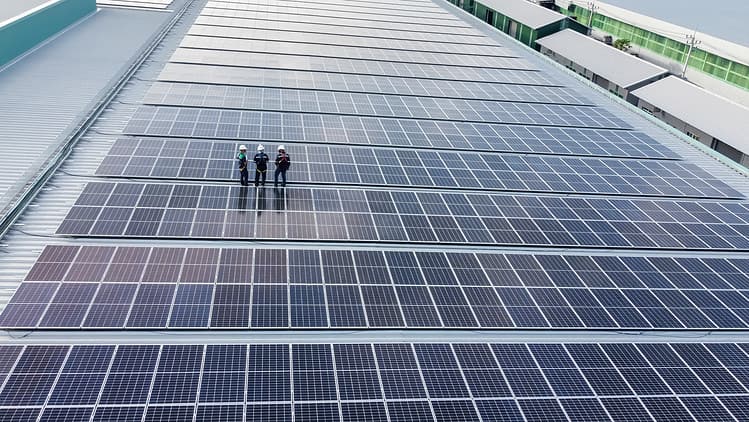
Introduction
Technology has become an integral part of our lives, and it has the potential to have a major impact on the environment. Technology can be used to reduce pollution, conserve resources, and even help mitigate climate change. In this article, we will explore how technology is impacting human impact on the environment.
Exploring the Impact of Technology on Climate Change
Climate change is one of the most pressing issues facing our planet today, and technology can play an important role in mitigating its effects. According to the World Economic Forum, “The use of technology to reduce carbon emissions and create more sustainable energy systems is essential for achieving the goals set out in the Paris Agreement.”
How Technology Can Help Reduce Carbon Emissions
One of the ways technology can help reduce carbon emissions is by improving energy efficiency. Technologies such as solar panels and wind turbines can be used to generate electricity without burning fossil fuels. Additionally, advances in battery technology are making it easier to store and use renewable energy sources. This can help reduce dependence on traditional energy sources such as coal and oil.
The Role Technology Can Play in Mitigating Climate Change
In addition to reducing carbon emissions, technology can also be used to monitor and track climate change. For example, satellites can be used to measure changes in sea levels, air temperature, and other factors. This data can then be used to inform decision-making and policy around climate change.
The Role of Technology in Reducing Pollution and Waste
Pollution and waste are major contributors to climate change and other environmental problems. Technology can help reduce both by making it easier to manage and recycle materials. Additionally, automation can help reduce pollution from factories and other industrial sites.
How Technologies Can Help Manage Waste Efficiently
Technologies such as sensor networks and machine learning can be used to monitor waste streams and identify areas where improvements can be made. This data can then be used to develop strategies for more efficient waste management. Additionally, new technologies such as 3D printing can help reduce waste by allowing for more efficient production processes.
How Automation Can Help Reduce Pollution
Automation can also help reduce pollution by streamlining production processes and eliminating manual tasks. This can help reduce emissions from factories and other industrial sites. Additionally, automation can help reduce the need for hazardous chemicals and materials, which can further reduce pollution.

Examining the Pros and Cons of Environmental Technologies
Environmental technologies can have both positive and negative effects on the environment. While they can help reduce emissions and waste, they can also potentially cause harm if not properly managed or implemented.
Benefits of Environmental Technologies
Environmental technologies can help reduce emissions, conserve resources, and improve water quality. Additionally, they can help increase efficiency and productivity, resulting in economic savings. According to the United Nations Environment Programme, “By 2030, investments in green infrastructure could result in global savings of up to US$1.8 trillion per year.”
Potential Drawbacks of Environmental Technologies
While environmental technologies can offer many benefits, they can also have potential drawbacks. For example, some technologies may require large amounts of energy or land, which can lead to environmental damage. Additionally, some technologies may introduce new pollutants or cause other unintended consequences.
Assessing the Efficiency of Green Energy Sources
Renewable energy sources such as solar, wind, and hydro power can help reduce reliance on fossil fuels and reduce emissions. However, these sources come with their own challenges and potential drawbacks.
The Advantages of Renewable Energy Sources
Renewable energy sources can provide clean, reliable, and affordable energy. They can also help reduce reliance on fossil fuels and reduce emissions. Additionally, renewable energy sources can create jobs and stimulate local economies.
Challenges Faced in Implementing Green Energy Sources
One of the challenges faced in implementing renewable energy sources is the cost. Renewable energy sources can be expensive to install and maintain. Additionally, there are often regulatory and political hurdles that must be overcome before renewable energy sources can be implemented. Finally, some renewable energy sources, such as hydropower, can have a negative impact on local ecosystems.
Investigating the Impact of Automation on Sustainability
Automation can help improve efficiency and reduce emissions, but it also carries certain risks. Automation can lead to job losses, which can have a negative impact on communities and economies.
How Automation Can Help Improve Efficiency
Automation can help improve efficiency by eliminating manual tasks and streamlining production processes. This can lead to cost savings and increased productivity. Additionally, automation can help reduce emissions from factories and other industrial sites.
The Potential Risks of Automation
One of the potential risks of automation is job losses. Automation can replace human labor and lead to unemployment, which can have a negative impact on communities and economies. Additionally, automation can lead to increased inequality, as those who are able to access and benefit from automated technologies may be at an advantage over those who cannot.

Evaluating the Impact of Technology on Water Resources
Water resources are essential to life on Earth, and technology can help improve the management and conservation of these resources. Additionally, technology can also have a negative impact on water resources.
How Technology Can Help Improve Water Management
Technology can be used to monitor water resources and detect leaks or contamination. Additionally, technologies such as desalination can be used to make seawater drinkable. Finally, technologies such as drip irrigation can be used to conserve water and reduce waste.
Potential Adverse Effects of Technology on Water Resources
One of the potential adverse effects of technology on water resources is pollution. Technologies such as fracking can contaminate water supplies with toxic chemicals. Additionally, poor wastewater management can lead to the release of pollutants into water sources. Finally, climate change can lead to drought and shortages of water.

Analyzing the Effects of Smart Cities on the Environment
Smart cities are urban areas that use technology to improve efficiency and reduce emissions. While these cities can have many benefits, they can also have potential drawbacks.
Benefits of Smart Cities
Smart cities can help reduce emissions by making transportation and energy consumption more efficient. Additionally, these cities can provide better services for citizens, such as improved healthcare and education. Finally, smart cities can help reduce waste by using technologies such as sensors and machine learning to monitor and manage resources.
Potential Drawbacks of Smart Cities
One of the potential drawbacks of smart cities is privacy concerns. As these cities become more connected and reliant on technology, there is a risk of data being collected and used without consent. Additionally, smart cities can be expensive to build and maintain, which can place a burden on taxpayers. Finally, smart cities can lead to gentrification, which can displace lower-income residents.
Conclusion
Technology can have a major impact on the environment, both positive and negative. It can help reduce emissions and pollution, conserve resources, and even help mitigate climate change. However, it can also have potential drawbacks, such as job losses, pollution, and privacy concerns. It is important to carefully consider the potential impacts of technology on the environment before implementing it.
Recap of Key Points
In this article, we explored how technology is impacting human impact on the environment. We discussed how technology can help reduce carbon emissions and pollution, the pros and cons of environmental technologies, the advantages of renewable energy sources, the impact of automation on sustainability, and the effects of smart cities on the environment.
Call-to-Action
It is important to consider the potential impacts of technology on the environment before implementing it. If you are considering implementing a new technology, it is important to do your research and make sure it is the right choice for your situation.




